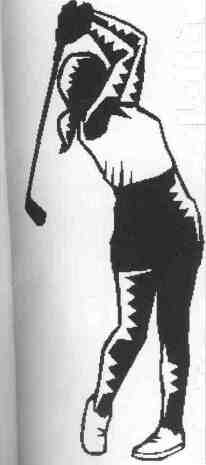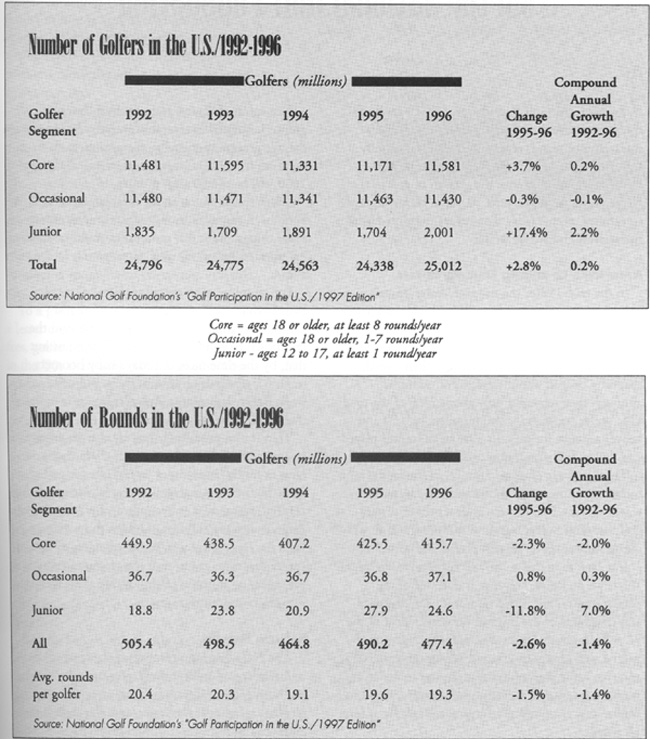SPECIAL FOCUS
Who Plays Golf?
According to the National Golf Foundation, the aging of America
is still key to golfs prospects for growth

|
There are a number of stories to be found in the
1997 edition of the National Golf Foundation's
(NGF) annual "Golf Participation in the U.S."
report.
The top line numbers, for example, show that in
1996 the game's two main growth indicators—
number of golfers and rounds played—totaled 25
million and 477 million respectively, which is pretty
much where they're been for the past six years now.
By the same token, there's other data in the report
that says some interesting changes are taking place
which are being followed with interest by those
who, like the NGF, believe that the baby boom
and the aging of America will be working in
golfs favor in the years ahead.
The scenario for this story can be found
in the age group breakouts contained in
this year's report. These crosstabs show
that the senior golfer segment (age 50 and
over) is the only one that has exhibited
any appreciable growth in recent years.
Since 1991, for example, the senior
segment has grown 16 percent, or by
nearly one million golfers. Todays 6.4
million senior golfers now represent 26
percent of all golfers. Five years ago, they
accounted for just 22 percent. By the same
token, all other age groups have lost members
or, at best, remained level during this time
period.
"We've been saying for several years now
that, when they leave their child-rearing years
and begin to approach retirement, todays 78
million baby boomers will be one of the driving
economic forces in golf," says Richard Norton,
the vice president who heads up NGF's research
department.
Norton is quick to point out that the first wave of
this generation turned 50 last year and that there's
much to be gained by the golf industry if these new
seniors behave like their predecessors and play more
often as they get older.
|
Rounds vs. Revenues
"Todays seniors are among the game's most avid
players," says Norton. "They not only average about
36 rounds a year—which is about three times what
it is for all other golfers—they also spend half again
as much on golf."
Norton also points out that the current leveling
off in golf participation does not appear to have had
a negative impact on golf consumer spending which
a 1995 NGF research report showed as nearly
doubling since 1986, going from $7.8 to $15.1
billion.
"It would appear," he says, "that, while they
might not be playing more, today's golfers are
willing to spend more on everything from equipment to lessons and fees. So, although rounds
played may be down at some courses, the average
revenue per round may be going up."
Those Bellwether Beginners
In addition to seniors, the NGF's annual surveys
measure another market segment that is equally
important to golf and its economy: beginning
golfers, i.e., those people who take up the game for
the first time each year.
(article continues on page 36)
May / June 1997 / 33
SPECIAL FOCUS
For the past 10 years, the game has been seeing
approximately two million beginners a year, with the
18-29 age group producing the largest single sub-segment. Prior to 1996, the age group regularly
accounted for about 35 percent of all beginning
golfers. Last year, it jumped to 42 percent.
The NGF will be paying special attention to this
percentage in the years ahead because it's one that
will verify another belief that's held by the NGF and
others, i.e., that golfs future growth is tied also to a
generation known as the "echo boomers" . . . those
72 million young men and women who were born
between 1977 and 1993 and whose parents are the
original boomers. The leading edge of this group
turned 18 in 1996.
"We expect to see the 18 to 29 age group become
even more predominate among beginners as more
echo boomers move into their twenties," says
Norton. "And, of course, one of the big
unknowns here is the influence that players
like Tiger Woods and Karrie Webb will be
having on these young men and women
over the course of the next several years."
Other Insights
Among the other findings in this years
report:
• Avid Golfers (25+ rounds per year)
The size of this group has remained
essentially unchanged over the past six
years. It numbers 5.3 million, which is
about where it has been since 1991. Half of
all avids are age 50 or older. Eighty-two
percent are male.
• Core Golfers (8+ rounds per year)
Although they constitute roughly half of all
golfers, they account for close to 90 percent
of all rounds played. Their average age: 45.
• Female Golfers
Although they comprise just 21 percent of
all golfers, they continue to account for
more than 30 percent of all beginning
golfers. Also, avid female golfers compare
very favorably to their male counterparts
when it comes to rounds played. They
average just five less rounds per year (59 vs.
64). The growth potential of this segment
is reflected in the fact that the participation
rate among women is about 5 percent
versus 18.5 percent for males.
• Public vs. Private Golf
Approximately 80 percent of all golfers in
the U.S. today play the majority of their
rounds at public courses. On the other
hand, the average private club golfer plays
more than twice as many rounds per year
(34) as the average public golfer (16). The
private club golfer also leads when it comes
to household income, but not by as much
as you might think. They average $69,700
vs. $57,700 for all public golfers.
36 / Illinois Parks and Recreation
WHO PLAYS GOLF?
Factoring In the Margins
The national mail panel survey upon which this
report is based was conducted for the NGF by
Market Facts Inc. of Chicago, one of the world's
largest market research organizations,
As in past years, a total of 30,000 households
were surveyed and weighted with U.S. census
demographic variables to make them nationally
representative. The large sample size produces a low
margin of error. For example, in estimating number
of golfers, it allows a margin of +/-2 percent with 90
percent confidence.
"In looking over the fluctuations that have
occurred recently in total number of players and
average rounds played per golfer," says Norton,
"we've noted that these changes have all been well
within our margins of error. And it's for this reason
that, when we reflect on the past six years, we look
at these growth indicates as remaining essentially
level."
Article reprinted with permission granted by the National Golf Foundation
(NGF), 1150 South U. S. Highway One, Suite 401, Jupiter, FL 33477,
561.744.6006. Copies of 'Golf Participation in the U.S. /1997 Edition"can
be obtained from NGF Membership Services at 1.800.733.6006.

May / June 1997/ 37
This page is created by
Sam S. Manivong, Illinois Periodicals Online Coordinator
Illinois Periodicals Online (IPO) is a digital imaging project at the
Northern Illinois University Libraries funded by the Illinois State Library
|

